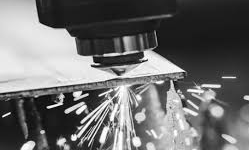Imagine walking into a massive festival. Instead of music, there are airplanes. Instead of food stalls, there are giant aircraft displays. Instead of games, you see flying cars, drones, military jets, and futuristic designs that look straight out of a sci-fi movie. This is the Paris Air Show.
But behind all the shiny planes and excited crowds, there is a quiet worker playing a huge role: laser cutting machines. Let’s break it all down simply so anyone can understand how developments at the Paris Air Show are directly tied to laser cutting technology.
The Paris Air Show is the world’s biggest and most important aviation event. Every two years, aviation companies, governments, military officials, investors, engineers, and aviation lovers come together in Paris. They show off the newest planes, helicopters, drones, and flying cars. Deals are signed. New partnerships are formed. Innovations are revealed.
Because what happens at the Paris Air Show today shapes how we will travel tomorrow. It affects:
-
The planes we fly on for holidays.
-
The flying taxis we might use one day.
-
The military jets protecting countries.
-
The drones delivering packages to our homes.
And behind all of these? Laser cutting machines are busy cutting, shaping, and preparing the parts that make these machines possible.
-
Electric Planes: Companies showed new battery-powered planes that don’t need fuel.
-
Flying Taxis: Small electric helicopters designed to transport people within cities.
-
Unmanned Drones: High-tech drones for military, delivery, and rescue operations.
-
Sustainable Aviation: Airplanes that produce fewer emissions using special fuels and lightweight designs.
-
Advanced Military Jets: New stealth fighter jets with cutting-edge technology.
Every one of these developments needs highly precise parts. That’s where laser cutting machines step in.
Laser cutting machines act like super-precise scissors. But instead of cutting paper, they cut metal, plastic, composites, and even futuristic materials like carbon fiber. In aviation, every gram matters. Lighter planes are more fuel-efficient, environmentally friendly, and cheaper to operate.
Let’s look at some examples:
-
Electric Plane Batteries: Battery compartments must be lightweight but strong. Lasers cut the exact frames.
-
Flying Taxi Rotors: Rotors must be perfectly balanced. Lasers cut these with micron-level precision.
-
Drone Frames: Drones need lightweight, aerodynamic frames. Laser cutting makes this possible.
-
Military Aircraft Panels: Stealth planes use special materials that lasers cut without damaging.
-
Engine Parts: Complex engine brackets, housings, and pipes all rely on laser cutting.
Without laser cutting machines, these high-tech aircraft wouldn’t exist as we know them.
A company designs a new flying taxi. To build it:
-
They need lightweight metals and composites.
-
The parts must be cut precisely to fit perfectly.
-
Laser cutting machines do the job.
-
The flying taxi flies smoothly, safely, and efficiently.
Now multiply that by hundreds of companies at the Paris Air Show. Each new design means more parts, more cutting, and more work for laser cutting machine makers.
SLTL Group makes advanced laser cutting machines that companies use to build airplane parts. As aviation technology grows, so does the need for SLTL’s machines. Here’s how:
-
Higher Precision Needs: New aircraft designs require even tighter tolerances. SLTL’s machines cut with extreme accuracy.
-
Complex Shapes: Modern designs have unusual shapes that are difficult to cut with old machines. Lasers handle this easily.
-
New Materials: Carbon fiber, titanium, and advanced alloys are tough. Lasers cut them cleanly.
-
IoT-Enabled Efficiency: SLTL’s smart machines optimize cuts, reduce waste, and improve productivity.
When aviation grows, SLTL benefits directly.
Electric planes are the star of Paris Air Show 2025. But they need:
-
Lightweight battery housings
-
Custom cooling systems
-
Compact structural parts
Lasers cut all these with zero contact, meaning less chance of damage and waste. As electric aviation rises, so does demand for laser cutting.
Military jets require even tighter manufacturing standards:
-
Stealth panels with secret shapes
-
Heat-resistant parts for supersonic speeds
-
Lightweight airframes for better maneuverability
Lasers handle these jobs perfectly, helping manufacturers meet military demands shown at the Paris Air Show.
Imagine a small helicopter picking you up from your rooftop. This dream is becoming real. But flying taxis need:
-
Ultra-light rotors
-
Strong but light frames
-
Compact control systems
Laser cutting machines provide the exact cuts for these critical components.
Drones are everywhere now — from delivering packages to surveillance. Drones require tiny, detailed parts that are perfect for laser cutting.
At Paris Air Show 2025, many drone makers displayed models made possible by precise laser cutting.
Space companies displayed:
-
Rocket parts
-
Satellite structures
-
Space station components
All require lightweight, durable, and complex shapes that laser cutting machines handle efficiently. Even space exploration needs lasers!
Trade Deals Signed at Paris Air Show: The Ripple Effect
The Paris Air Show isn’t just about showing off planes. It’s about business deals. When governments and companies sign big contracts:
-
More planes get ordered.
-
More parts need to be made.
-
More laser cutting machines are purchased.
A single deal can trigger a wave of new orders across the laser cutting industry.
The Domino Effect (Simple Version):
-
Airline orders 200 new planes.
-
Manufacturers need thousands of new parts.
-
Laser cutting machines are needed to cut these parts.
-
SLTL and other companies sell more machines.
A handshake at Paris leads to business for laser companies worldwide.
Challenges and Opportunities Ahead
While Paris Air Show brings excitement, there are challenges:
-
Supply Chain Issues: Getting raw materials from around the world can be hard.
-
Rising Material Costs: Metals and composites are expensive.
-
Global Trade Disputes: Tariffs and politics can slow trade.
-
Environmental Rules: New green regulations require better technology.
Companies like SLTL that innovate with smart, efficient, and eco-friendly machines will be best positioned to grow.
Smart Laser Cutting: The Future is Bright
SLTL’s IoT-enabled laser cutting machines are future-ready. They:
-
Self-monitor for maintenance needs
-
Optimize cutting paths automatically
-
Reduce energy consumption
-
Deliver consistent, high-quality results
These smart features attract aviation companies looking to stay competitive in a fast-moving world.
Emerging Markets: New Growth Areas
While big players like the USA, Europe, and China dominate today, new regions are growing too:
-
Southeast Asia
-
Africa
-
South America
These markets are investing heavily in aviation. As they build new planes, drones, and infrastructure, they will need laser cutting machines to support growth.
Conclusion: Why Paris Air Show 2025 Matters for Laser Cutting
-
Every new plane or drone design creates demand for laser cutting.
-
Electric and flying taxis multiply this demand.
-
Trade deals at the show open new business.
-
Military contracts require the highest precision.
-
Space exploration adds even more opportunities.
Behind every futuristic aircraft at the Paris Air Show stands an army of laser cutting machines, quietly making dreams fly.
For companies like SLTL Group, staying close to the Paris Air Show developments isn’t just smart—it’s essential for growth and success.
Final Thought:
Next time you hear about the Paris Air Show, picture those laser beams cutting away in a factory far from the spotlight, helping build the next generation of flight.
magine walking into a massive festival. Instead of music, there are airplanes. Instead of food stalls, there are giant aircraft displays. Instead of games, you see flying cars, drones, military jets, and futuristic designs that look straight out of a sci-fi movie. This is the Paris Air Show.
But behind all the shiny planes and excited crowds, there is a quiet worker playing a huge role: laser cutting machines. Let’s break it all down simply so anyone can understand how developments at the Paris Air Show are directly tied to laser cutting technology.
What is the Paris Air Show?
The Paris Air Show is the world’s biggest and most important aviation event. Every two years, aviation companies, governments, military officials, investors, engineers, and aviation lovers come together in Paris. They show off the newest planes, helicopters, drones, and flying cars. Deals are signed. New partnerships are formed. Innovations are revealed.
Why Should You Care?
Because what happens at the Paris Air Show today shapes how we will travel tomorrow. It affects:
-
The planes we fly on for holidays.
-
The flying taxis we might use one day.
-
The military jets protecting countries.
-
The drones delivering packages to our homes.
And behind all of these? Laser cutting machines are busy cutting, shaping, and preparing the parts that make these machines possible.
Big Trends at the Paris Air Show 2025
-
Electric Planes: Companies showed new battery-powered planes that don’t need fuel.
-
Flying Taxis: Small electric helicopters designed to transport people within cities.
-
Unmanned Drones: High-tech drones for military, delivery, and rescue operations.
-
Sustainable Aviation: Airplanes that produce fewer emissions using special fuels and lightweight designs.
-
Advanced Military Jets: New stealth fighter jets with cutting-edge technology.
Every one of these developments needs highly precise parts. That’s where laser cutting machines step in.
How Are Laser Cutting Machines Involved?
Laser cutting machines act like super-precise scissors. But instead of cutting paper, they cut metal, plastic, composites, and even futuristic materials like carbon fiber. In aviation, every gram matters. Lighter planes are more fuel-efficient, environmentally friendly, and cheaper to operate.
Let’s look at some examples:
-
Electric Plane Batteries: Battery compartments must be lightweight but strong. Lasers cut the exact frames.
-
Flying Taxi Rotors: Rotors must be perfectly balanced. Lasers cut these with micron-level precision.
-
Drone Frames: Drones need lightweight, aerodynamic frames. Laser cutting makes this possible.
-
Military Aircraft Panels: Stealth planes use special materials that lasers cut without damaging.
-
Engine Parts: Complex engine brackets, housings, and pipes all rely on laser cutting.
Without laser cutting machines, these high-tech aircraft wouldn’t exist as we know them.
Let’s Imagine a Simple Example:
A company designs a new flying taxi. To build it:
-
They need lightweight metals and composites.
-
The parts must be cut precisely to fit perfectly.
-
Laser cutting machines do the job.
-
The flying taxi flies smoothly, safely, and efficiently.
Now multiply that by hundreds of companies at the Paris Air Show. Each new design means more parts, more cutting, and more work for laser cutting machine makers.
How SLTL Group Fits Into the Picture
SLTL Group makes advanced laser cutting machines that companies use to build airplane parts. As aviation technology grows, so does the need for SLTL’s machines. Here’s how:
-
Higher Precision Needs: New aircraft designs require even tighter tolerances. SLTL’s machines cut with extreme accuracy.
-
Complex Shapes: Modern designs have unusual shapes that are difficult to cut with old machines. Lasers handle this easily.
-
New Materials: Carbon fiber, titanium, and advanced alloys are tough. Lasers cut them cleanly.
-
IoT-Enabled Efficiency: SLTL’s smart machines optimize cuts, reduce waste, and improve productivity.
When aviation grows, SLTL benefits directly.
Electric Planes and the Laser Connection
Electric planes are the star of Paris Air Show 2025. But they need:
-
Lightweight battery housings
-
Custom cooling systems
-
Compact structural parts
Lasers cut all these with zero contact, meaning less chance of damage and waste. As electric aviation rises, so does demand for laser cutting.
Military Aviation: Even More Precision Needed
Military jets require even tighter manufacturing standards:
-
Stealth panels with secret shapes
-
Heat-resistant parts for supersonic speeds
-
Lightweight airframes for better maneuverability
Lasers handle these jobs perfectly, helping manufacturers meet military demands shown at the Paris Air Show.
Flying Taxis: The Urban Air Revolution
Imagine a small helicopter picking you up from your rooftop. This dream is becoming real. But flying taxis need:
-
Ultra-light rotors
-
Strong but light frames
-
Compact control systems
Laser cutting machines provide the exact cuts for these critical components.
Drones: Small but Booming Business
Drones are everywhere now — from delivering packages to surveillance. Drones require tiny, detailed parts that are perfect for laser cutting.
At Paris Air Show 2025, many drone makers displayed models made possible by precise laser cutting.
Space Exploration Joins the Show
Space companies displayed:
-
Rocket parts
-
Satellite structures
-
Space station components
All require lightweight, durable, and complex shapes that laser cutting machines handle efficiently. Even space exploration needs lasers!
Trade Deals Signed at Paris Air Show: The Ripple Effect
The Paris Air Show isn’t just about showing off planes. It’s about business deals. When governments and companies sign big contracts:
-
More planes get ordered.
-
More parts need to be made.
-
More laser cutting machines are purchased.
A single deal can trigger a wave of new orders across the laser cutting industry.
The Domino Effect (Simple Version):
-
Airline orders 200 new planes.
-
Manufacturers need thousands of new parts.
-
Laser cutting machines are needed to cut these parts.
-
SLTL and other companies sell more machines.
A handshake at Paris leads to business for laser companies worldwide.
Challenges and Opportunities Ahead
While Paris Air Show brings excitement, there are challenges:
-
Supply Chain Issues: Getting raw materials from around the world can be hard.
-
Rising Material Costs: Metals and composites are expensive.
-
Global Trade Disputes: Tariffs and politics can slow trade.
-
Environmental Rules: New green regulations require better technology.
Companies like SLTL that innovate with smart, efficient, and eco-friendly machines will be best positioned to grow.
Smart Laser Cutting: The Future is Bright
SLTL’s IoT-enabled laser cutting machines are future-ready. They:
-
Self-monitor for maintenance needs
-
Optimize cutting paths automatically
-
Reduce energy consumption
-
Deliver consistent, high-quality results
These smart features attract aviation companies looking to stay competitive in a fast-moving world.
Emerging Markets: New Growth Areas
While big players like the USA, Europe, and China dominate today, new regions are growing too:
-
Southeast Asia
-
Africa
-
South America
These markets are investing heavily in aviation. As they build new planes, drones, and infrastructure, they will need laser cutting machines to support growth.
Conclusion: Why Paris Air Show 2025 Matters for Laser Cutting
-
Every new plane or drone design creates demand for laser cutting.
-
Electric and flying taxis multiply this demand.
-
Trade deals at the show open new business.
-
Military contracts require the highest precision.
-
Space exploration adds even more opportunities.
Behind every futuristic aircraft at the Paris Air Show stands an army of laser cutting machines, quietly making dreams fly.
For companies like SLTL Group, staying close to the Paris Air Show developments isn’t just smart—it’s essential for growth and success.
Final Thought:
Next time you hear about the Paris Air Show, picture those laser beams cutting away in a factory far from the spotlight, helping build the next generation of flight.










